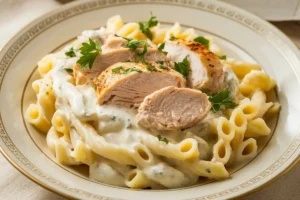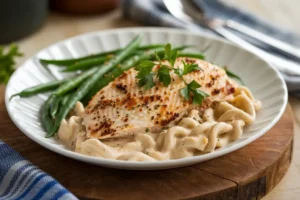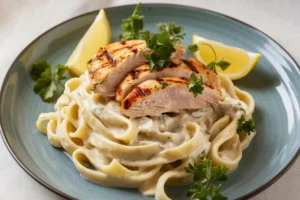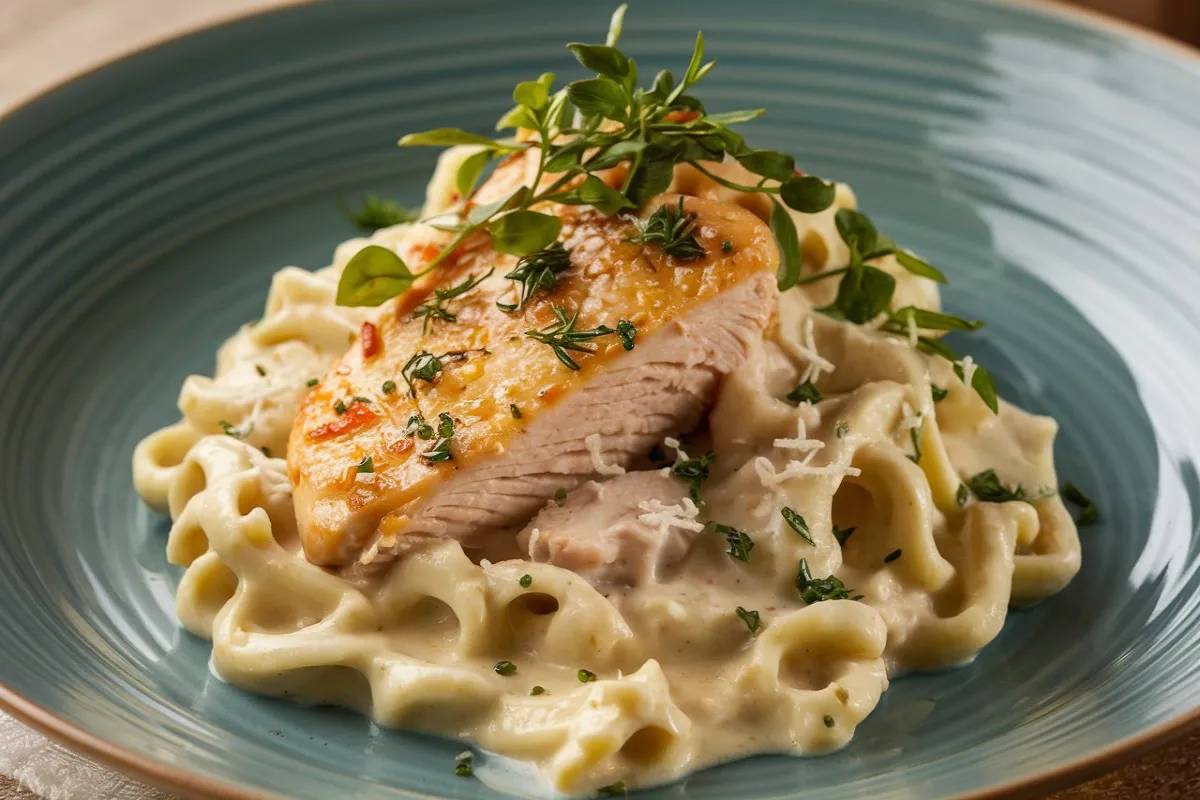The Ultimate Guide to Perfect Chicken Alfredo: A Detailed Recipe Breakdown
Chicken Alfredo is a classic dish that has stood the test of time, known for its creamy, rich sauce paired with tender chicken and pasta. It’s a comfort food staple, loved by many for its simplicity and flavor. In this article, we will dive deep into the art of making the perfect Chicken Alfredo at home, exploring everything from ingredient selection to troubleshooting common mistakes. This guide will ensure you can recreate this delicious dish in your own kitchen, with tips to suit any level of cooking expertise.
Introduction to Chicken Alfredo
Chicken Alfredo has a storied history, with its roots in Italy. Originally, Alfredo sauce was a simple mixture of butter and Parmesan cheese, used to coat fettuccine. The addition of cream and chicken is an American twist that has made this dish even more indulgent. The combination of creamy sauce, tender chicken, and al dente pasta makes Chicken Alfredo a favorite for both weeknight dinners and special occasions.
Whether you’re a seasoned cook or a beginner, understanding the basics of this dish will help you make a meal that’s truly memorable. In this guide, we’ll cover the essential ingredients, the best techniques for cooking the chicken and sauce, and how to avoid common pitfalls.
Essential Ingredients for Chicken Alfredo
Core Ingredients
The key to a great Chicken Alfredo lies in the quality of its ingredients. Here’s what you’ll need:
- Chicken: Boneless, skinless chicken breasts are the most common choice, but chicken thighs can also be used for a juicier result.
- Pasta: Fettuccine is the traditional pasta for Alfredo, but you can substitute it with penne, linguine, or any other pasta you prefer.
- Butter: Unsalted butter allows you to control the seasoning of the dish.
- Heavy Cream: The foundation of the creamy Alfredo sauce; opt for high-quality cream for the best results.
- Parmesan Cheese: Freshly grated Parmesan is essential for the sauce’s texture and flavor. Pre-grated cheese can contain anti-caking agents that might affect the smoothness of the sauce.
- Garlic: Fresh garlic adds a subtle depth to the sauce that’s irresistible.
- Olive Oil: Used for cooking the chicken to add flavor and prevent sticking.
- Salt and Pepper: These basic seasonings are crucial for enhancing the flavors of your dish.
Optional Ingredients
- Mushrooms: Add for an earthy flavor.
- Spinach: Incorporates a fresh, green element.
- Broccoli: A popular addition for added texture and nutrition.
- Nutmeg: Just a pinch can enhance the flavor of the sauce.
When gathering your ingredients, quality is key. Fresh, high-quality ingredients will make a significant difference in the final dish, especially when it comes to the cream and cheese.
Preparing the Chicken

The first step to making Chicken Alfredo is preparing the chicken itself. How you cook the chicken will impact the overall texture and flavor of the dish.
Choosing the Right Cut
- Chicken Breasts: Preferred for their lean texture and ease of cooking.
- Chicken Thighs: A fattier option that can add more flavor but may require longer cooking.
Seasoning the Chicken
Before cooking, season the chicken generously with salt, pepper, and a little olive oil. You can also add garlic powder or Italian seasoning for extra flavor.
Cooking Methods
- Pan-Seared Chicken: Heat olive oil in a skillet over medium heat. Cook the chicken for 6-7 minutes per side until golden brown and fully cooked. This method creates a nice crust on the outside while keeping the inside juicy.
- Grilled Chicken: For a smoky flavor, grill the chicken over medium heat until it reaches an internal temperature of 165°F.
- Baked Chicken: If you prefer baking, place the seasoned chicken in a preheated oven at 375°F for about 25 minutes or until cooked through.
Pro Tip: Let the chicken rest for a few minutes after cooking. This allows the juices to redistribute, making the chicken more flavorful and tender.
For a more detailed guide on choosing the right type of chicken and cooking methods, check out this informative resource on cooking chicken.
Making the Alfredo Sauce
The Alfredo sauce is the heart of Chicken Alfredo. A perfectly creamy and smooth sauce is what makes this dish so indulgent.
Traditional Alfredo Sauce Recipe
Here’s how to make a classic Alfredo sauce:
- Melt Butter: In the same skillet used for cooking the chicken, melt 4 tablespoons of unsalted butter over medium heat.
- Add Garlic: Sauté 2-3 cloves of minced garlic until fragrant, about 1 minute.
- Pour in Cream: Slowly add 1 cup of heavy cream to the skillet, stirring constantly. Bring the mixture to a simmer.
- Stir in Parmesan: Gradually whisk in 1 cup of freshly grated Parmesan cheese until the sauce is smooth and creamy.
- Season: Add salt and pepper to taste. You can also add a pinch of nutmeg if desired.
Variations: If you want a lighter version, consider using half-and-half instead of heavy cream. For a garlic lover’s twist, you can increase the amount of garlic or even add roasted garlic for a deeper flavor.
For those interested in making traditional Alfredo sauce from scratch, you can follow this traditional Alfredo sauce recipe.
Cooking the Pasta

While the sauce is simmering, it’s time to cook the pasta. Here’s how to get it just right:
Pasta Selection
- Fettuccine: The classic choice for Alfredo.
- Penne: Great for holding the sauce in its ridges.
- Linguine: A lighter option that pairs well with creamy sauces.
Cooking Instructions
- Boil Water: Bring a large pot of salted water to a rolling boil.
- Cook Pasta: Add the pasta to the boiling water and cook according to the package instructions until al dente, typically 8-10 minutes.
- Reserve Pasta Water: Before draining, reserve about 1 cup of pasta water. This starchy water can be used to adjust the consistency of your sauce.
- Drain: Drain the pasta and immediately toss it with a little olive oil to prevent sticking.
Pro Tip: Cooking the pasta al dente (firm to the bite) is crucial because it will continue to cook slightly when mixed with the hot Alfredo sauce.
Combining Ingredients
Now that your chicken, sauce, and pasta are ready, it’s time to bring everything together:
- Slice the Chicken: Cut the cooked chicken into thin slices or bite-sized pieces.
- Mix with Sauce: Add the drained pasta to the Alfredo sauce and toss until evenly coated.
- Add Chicken: Gently fold in the sliced chicken, making sure every piece is well-coated with the sauce.
- Adjust Consistency: If the sauce is too thick, add a splash of the reserved pasta water until the desired consistency is achieved.
For a perfect finish, sprinkle extra Parmesan and chopped parsley on top before serving.
Serving Suggestions
Presentation can make a big difference in how your Chicken Alfredo is received. Here are some tips for serving:
- Plating: Use tongs to twirl the pasta into a neat pile on each plate. Top with slices of chicken.
- Garnishing: Finish with a sprinkle of freshly grated Parmesan cheese and a pinch of black pepper. A few parsley leaves add a pop of color.
- Side Dishes: Serve with a simple green salad or garlic bread to balance the richness of the dish.
Pro Tip: If you want to elevate your Chicken Alfredo even further, consider drizzling a little truffle oil over the top before serving.
Popular Chicken Alfredo Variations
One of the best things about Chicken Alfredo is its versatility. Here are some popular variations you might want to try:
Baked Chicken Alfredo
After preparing the dish as usual, transfer the Chicken Alfredo to a baking dish. Top with mozzarella cheese and bake at 375°F until the cheese is bubbly and golden brown, about 15 minutes. This creates a deliciously cheesy crust on top.
One-Pot Chicken Alfredo
For a quicker version, you can make Chicken Alfredo in a single pot. Cook the chicken first, then add the pasta, cream, and cheese directly to the pot. Simmer until the pasta is cooked and the sauce is thick and creamy.
Low-Carb Chicken Alfredo
For a low-carb or keto-friendly version, replace the pasta with spiralized zucchini or cauliflower rice. You can also use heavy cream and extra Parmesan cheese to maintain the richness of the sauce.
Vegetable Add-Ins: You can easily incorporate vegetables like broccoli, spinach, or mushrooms into your Chicken Alfredo. Simply sauté the vegetables along with the chicken, or blanch them and add them to the sauce just before serving.
For more ideas on how to create healthier versions of Chicken Alfredo, consider these healthier pasta alternatives.
Troubleshooting Common Mistakes
Even with the best intentions, things can sometimes go wrong in the kitchen. Here are some common issues you might encounter when making Chicken Alfredo, and how to fix them:
Overcooked Chicken
Problem: Chicken that is too dry or tough. Solution: Ensure you do not overcook the chicken by using a meat thermometer. The internal temperature should reach 165°F. Let the chicken rest after cooking to allow the juices to redistribute.
Curdled Sauce
Problem: Alfredo sauce that separates or becomes gritty. Solution: Keep the heat at medium to low when making the sauce. High heat can cause the cream to curdle. If the sauce starts to curdle, try whisking in a bit of cold cream or adding a teaspoon of cornstarch mixed with water.
Clumpy Parmesan
Problem: Cheese that doesn’t melt smoothly into the sauce. Solution: Always add Parmesan gradually and whisk continuously. Using freshly grated Parmesan ensures a smoother texture compared to pre-grated cheese, which often contains additives that prevent it from melting well.
Too Thick or Too Thin Sauce
Problem: Sauce consistency is off. Solution: If the sauce is too thick, add a little reserved pasta water to thin it out. If it’s too thin, continue to simmer the sauce until it reduces to the desired thickness.
Pro Tip: If reheating leftovers, do so gently over low heat to prevent the sauce from breaking.

Frequently Asked Questions (FAQs)
Here are some common questions people have about making Chicken Alfredo:
Can I use jarred Alfredo sauce?
Yes, you can, but making your own Alfredo sauce is relatively simple and allows you to control the ingredients and flavor. Homemade sauce tends to be fresher and more flavorful.
What’s the best way to store Chicken Alfredo?
Store leftovers in an airtight container in the refrigerator. Chicken Alfredo will keep well for 3-4 days. Reheat gently on the stovetop or in the microwave, adding a splash of cream or milk to revive the sauce.
Can Chicken Alfredo be frozen?
Yes, you can freeze Chicken Alfredo, but the sauce may separate when thawed. To freeze, transfer the cooled dish to a freezer-safe container. Thaw in the refrigerator overnight before reheating.
How can I make Chicken Alfredo gluten-free?
To make a gluten-free Chicken Alfredo, simply use gluten-free pasta. Ensure that the Parmesan cheese and any other ingredients you use are also gluten-free.
Conclusion
Making the perfect Chicken Alfredo at home is a rewarding experience that doesn’t have to be complicated. By following this detailed guide, you can create a dish that is rich, creamy, and bursting with flavor. Whether you stick to the classic recipe or experiment with some of the variations, Chicken Alfredo is sure to become a favorite in your home.
Remember, the key to a great Chicken Alfredo is high-quality ingredients, careful preparation, and a little bit of patience. Don’t be afraid to make it your own by adding your favorite vegetables or tweaking the sauce to your liking. With practice, you’ll be able to whip up this comforting dish with confidence, delighting your family and friends every time.

